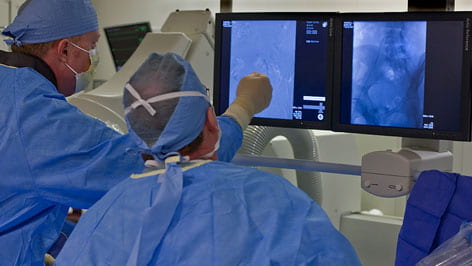Treating fibroids without surgery
Dr. Scott Goodwin takes a new approach to an age-old problem for women at UC Irvine Medical Center.

Nearly 600,000 hysterectomies are performed each year in the U.S. – a rate unchanged since World War II. Uterine fibroids, benign tumors in and around the walls of the uterus, account for half these procedures.
Dr. Scott Goodwin at UC Irvine Medical Center wants to change that.
“The interventional radiologist has a tool that may be able to spare women the pain, the bleeding and, sometimes, the infertility that come with uterine fibroids,” says Goodwin, chair of UCI’s Department of Radiological Sciences. The “tool,” uterine fibroid embolization, does not require invasive surgery.
UFE involves threading a catheter from a woman’s femoral artery to the uterine arteries, where the radiologist releases tiny, inert plastic spheres. The fibroid shrinks when enough spheres block its blood supply. Goodwin says the procedure takes about 90 minutes and usually requires only an overnight hospital stay. Most patients recover fully in about two weeks. This compares to five days in a hospital and a recovery period of up to six weeks with a traditional hysterectomy, in which the uterus is removed.
Goodwin’s journey to becoming one of the nation’s UFE pioneers began on Thanksgiving Day in 1994, when a UCLA Medical Center colleague sought his help to stop internal bleeding in a gynecological patient. He successfully employed an embolization technique that French physicians had introduced a few years earlier. By 1997, he was using it to treat uterine fibroids.
“Acceptance of the procedure grew gradually from there,” says Goodwin, who recently published an article about UFE in The New England Journal of Medicine. He’s currently working with doctors at UC Irvine’s Women’s Health Center to make it more widely available.
“Our goal is to offer each woman all the options for treating her condition without promoting any single one,” says Dr. Manuel Porto, chair of UCI’s Department of Obstetrics & Gynecology, which is ranked among America’s top gynecological service providers by U.S. News & World Report. “Fibroid embolization gives some women a wonderful opportunity for a less invasive procedure, and Scott is a pioneer in the field.”
Another option provided by UC Irvine is myomectomy, a minimally invasive procedure that involves shaving fibroids from the walls of the uterus. There is no incision or loss of fertility, but the technique is limited by a fibroid’s location. It cannot be performed if fibroids are inside the uterine wall or outside the uterus.
Fibroid embolization is not for everyone, Goodwin cautions, and its long-term effects are still being studied. While UFE spares the uterus, researchers don’t have sufficient data to determine whether the procedure hinders a woman’s ability to have children. However, doctors have reported cases in which women became pregnant and gave birth after having UFE.
“About half the people referred to me don’t get UFE,” Goodwin says. “They may undergo a myomectomy or a hysterectomy. But a woman who doesn’t plan on getting pregnant has many options, including UFE.”